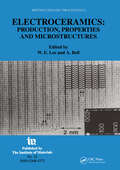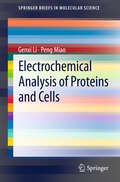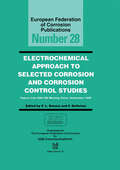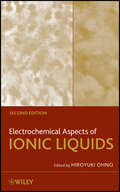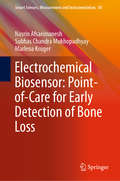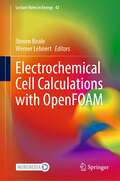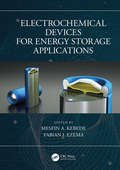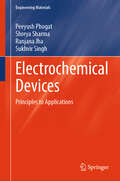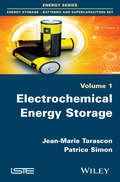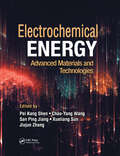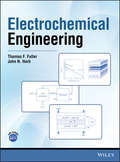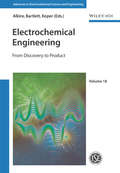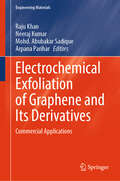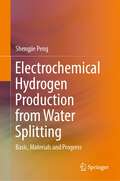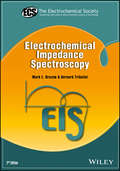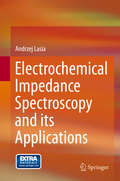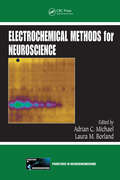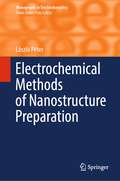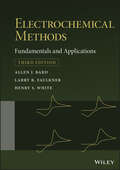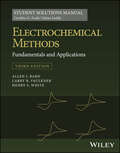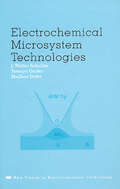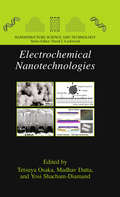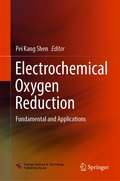- Table View
- List View
Electroceramics - Production, properties and microstructures: Proceedings of the Symposium Held as Part of the Condensed Matter and Materials Physics Conference, 20-22 December 1993, University of Leeds
by William E. Lee A. BellProceedings of the Symposium Held as Part of the Condensed Matter and Materials Physics Conference, on the 20-22 December 1993, at the University of Leeds. The man focus was Electroceramics - Production, properties and microstructures.
Electrochemical Analysis of Proteins and Cells
by Genxi Li Peng MiaoElectrochemical Analysis of Proteins and Cells presents the remarkable progress made over the years in the electrochemical analysis of proteins and cells, due to the rapid development of protein electrochemistry together with related technologies such as surface modification, molecular recognition, molecular assembly, and nanotechnology. As an interdisciplinary field combining electrochemistry, analytical chemistry, biochemistry, biophysics, biomedicine and material science, the electrochemical analysis of proteins and cells has attracted broad and extensive research interest. The main emphasis of this book is on the principles of electrochemical strategies and the practical utility of related detection systems, which is of great importance in all biological sciences, such as cell biology and molecular biology, as well as in biomedical fields like cancer research. This brief offers an up-to-date, easy-to-follow presentation of recent advances on the subject and can serve as a supplement for graduate-level courses in analytical chemistry, biochemistry, biophysics, biotechnology, biomedical engineering, etc. It may also help young scientists get an overview of this topic.
Electrochemical Approach to Selected Corrosion and Corrosion Control Studies (European Federation of Corrosion Publications)
by P. L. Bonora F. DeflorianThe collected papers from the 50th ISE Meeting held in Pavia , in September 1999. With special focus on Electrochemical Approach to Selected Corrosion And Corrosion Control Studies (number 28).
Electrochemical Aspects of Ionic Liquids
by Hiroyuki OhnoThe second edition is based on the original book, which has been revised, updated and expanded in order to cover the latest information on this rapidly growing field. The book begins with a description of general and electrochemical properties of ionic liquids and continues with a discussion of applications in biochemistry, ionic devices, functional design and polymeric ionic liquids. The new edition includes new chapters on Li ion Batteries and Actuators, as well as a revision of existing chapters to include a discussion on purification and the effects of impurities, adsorption of ionic liquids on interfaces and on the electrochemical double layer, among other topics.
Electrochemical Biosensor: Point-of-Care for Early Detection of Bone Loss (Smart Sensors, Measurement and Instrumentation #30)
by Marlena Kruger Subhas Chandra Mukhopadhyay Nasrin AfsarimaneshThis book presents the design of a robust, portable and low-cost PoC sensing system for the early detection of bone loss. The device can measure the level of CTx-I – one of the most sensitive biochemical markers of bone resorption – in serum and transmit the measured value to an IoT-based cloud server. The selectivity of the sensing system to CTx-I has been achieved by coating the sensor with artificial antibodies, prepared by means of molecular imprinting technology. Explaining all aspects of the system’s development in detail, the book will be of great interest to all engineers, researchers and scientists whose work involves the development of electrochemical sensors and PoC devices.
Electrochemical Biosensors for Whole Blood Analysis
by Shaoguang Li Hui Li Fan Xia Xiaoding LouThis book illustrates recent advances in developing sensitive and selective electrochemical biosensors for their whole blood application. Known to be a cutting-edge and fast-growing technology, electrochemical biosensors demonstrate their potential in laboratories, industries, and healthcare to achieve specific and direct target detection in complex media, and have become an emerging technology for guiding personalized medicine. The book first demonstrates methods and models to cover the detection of a variety of target molecules in whole blood, including ions, small molecules, nucleic acids, proteins, cells, etc. Then, it provides comments on various detection strategies employed to improve sensors' sensitivity, specificity, selectivity, and reproducibility as well as presenting the laws and principles. In addition, it summarizes achievements and challenges from recent years. Finally, it provides future perspectives and opportunities in electrochemical biosensors including point of care detection, molecular diagnostics and the integration of this sensor platform with multidisciplinary technologies, towards the ultimate goal of personalized medicine. The book integrates abundant viewpoints from multiple sciences and is helpful and valuable to a wide readership in the various fields of biochemistry, biophysics, bioengineering, and pharmaceutics.
Electrochemical Cell Calculations with OpenFOAM (Lecture Notes in Energy #42)
by Steven Beale Werner LehnertThis unique book is at the nexus of modern software programming practices and electrochemical process engineering. It is the authoritative text on developing open source software for many applications, including:• fuel cells;• electrolyzers; and• batteries.Written by experts in the field in the open source computational fluid dynamics (CFD) code suite OpenFOAM, this book is intended for process engineering professionals developing practical electrochemical designs for industry, as well as researchers focused on finding tomorrow’s answers today. The book covers everything from micro-scale to cell-scale to stack-scale models, with numerous illustrations and programming examples. Starting from a clear explanation of electrochemical processes and simple illustrative examples, the book progresses in complexity through a range of diverse applications. After reading this book, the reader is able to take command and control of model development as an expert. The book is aimed at all engineers and scientists with basic knowledge of calculus and programming in C++.
Electrochemical Devices for Energy Storage Applications
by Mesfin A. Kebede Fabian I. EzemaThis book explores a wide range of energy storage devices, such as a lithium ion battery, sodium ion battery, magnesium ion battery and supercapacitors. Providing a comprehensive review of the current field, it also discusses the history of these technologies and introduces next-generation rechargeable batteries and supercapacitors. This book will serve as a valuable reference for researchers working with energy storage technologies across the fields of physics, chemistry, and engineering. Features:• Edited by established authorities in the field, with chapter contributions from subject area specialists • Provides a comprehensive review of field • Up to date with the latest developments and research
Electrochemical Devices: Principles to Applications (Engineering Materials)
by Peeyush Phogat Shreya Sharma Ranjana Jha Sukhvir SinghThis book serves as a comprehensive guide for both beginners and researchers, offering insights into the diverse array of electrochemical devices and their intricate dependencies. It provides a comprehensive overview of electrochemical devices from fundamental principles to cutting-edge applications. By bringing together insights from materials science, chemistry, physics, engineering, and beyond, it offers a holistic understanding of the underlying mechanisms, design strategies, and practical considerations associated with these devices. The book begins by exploring of the fundamental principles of electrochemistry, laying the groundwork for understanding electrochemical reactions, charge transfer processes, and device operation mechanisms. Building upon this foundation, it delves into various types of electrochemical devices, including solar cells, photodetectors, sensors, batteries, and more.
Electrochemical Energy Storage
by Patrice Simon Jean-Marie TarasconThe electrochemical storage of energy has become essential in assisting the development of electrical transport and use of renewable energies. French researchers have played a key role in this domain but Asia is currently the market leader. Not wanting to see history repeat itself, France created the research network on electrochemical energy storage (RS2E) in 2011. This book discusses the launch of RS2E, its stakeholders, objectives, and integrated structure that assures a continuum between basic research, technological research and industries. Here, the authors will cover the technological advances as well as the challenges that must still be resolved in the field of electrochemical storage, taking into account sustainable development and the limited time available to us.
Electrochemical Energy: Advanced Materials and Technologies (Electrochemical Energy Storage and Conversion)
by Chao-Yang Wang Jiujun Zhang Xueliang Sun San Ping Jiang Pei Kang ShenElectrochemical Energy: Advanced Materials and Technologies covers the development of advanced materials and technologies for electrochemical energy conversion and storage. The book was created by participants of the International Conference on Electrochemical Materials and Technologies for Clean Sustainable Energy (ICES-2013) held in Guangzhou, China, and incorporates select papers presented at the conference. More than 300 attendees from across the globe participated in ICES-2013 and gave presentations in six major themes: Fuel cells and hydrogen energy Lithium batteries and advanced secondary batteries Green energy for a clean environment Photo-Electrocatalysis Supercapacitors Electrochemical clean energy applications and markets Comprised of eight sections, this book includes 25 chapters featuring highlights from the conference and covering every facet of synthesis, characterization, and performance evaluation of the advanced materials for electrochemical energy. It thoroughly describes electrochemical energy conversion and storage technologies such as batteries, fuel cells, supercapacitors, hydrogen generation, and their associated materials. The book contains a number of topics that include electrochemical processes, materials, components, assembly and manufacturing, and degradation mechanisms. It also addresses challenges related to cost and performance, provides varying perspectives, and emphasizes existing and emerging solutions. The result of a conference encouraging enhanced research collaboration among members of the electrochemical energy community, Electrochemical Energy: Advanced Materials and Technologies is dedicated to the development of advanced materials and technologies for electrochemical energy conversion and storage and details the technologies, current achievements, and future directions in the field.
Electrochemical Engineering
by Thomas F. Fuller John N. HarbA Comprehensive Reference for Electrochemical Engineering Theory and Application From chemical and electronics manufacturing, to hybrid vehicles, energy storage, and beyond, electrochemical engineering touches many industries—any many lives—every day. As energy conservation becomes of central importance, so too does the science that helps us reduce consumption, reduce waste, and lessen our impact on the planet. Electrochemical Engineering provides a reference for scientists and engineers working with electrochemical processes, and a rigorous, thorough text for graduate students and upper-division undergraduates. Merging theoretical concepts with widespread application, this book is designed to provide critical knowledge in a real-world context. Beginning with the fundamental principles underpinning the field, the discussion moves into industrial and manufacturing processes that blend central ideas to provide an advanced understanding while explaining observable results. Fully-worked illustrations simplify complex processes, and end-of chapter questions help reinforce essential knowledge. With in-depth coverage of both the practical and theoretical, this book is both a thorough introduction to and a useful reference for the field. Rigorous in depth, yet grounded in relevance, Electrochemical Engineering: Introduces basic principles from the standpoint of practical application Explores the kinetics of electrochemical reactions with discussion on thermodynamics, reaction fundamentals, and transport Covers battery and fuel cell characteristics, mechanisms, and system design Delves into the design and mechanics of hybrid and electric vehicles, including regenerative braking, start-stop hybrids, and fuel cell systems Examines electrodeposition, redox-flow batteries, electrolysis, regenerative fuel cells, semiconductors, and other applications of electrochemical engineering principles Overlapping chemical engineering, chemistry, material science, mechanical engineering, and electrical engineering, electrochemical engineering covers a diverse array of phenomena explained by some of the important scientific discoveries of our time. Electrochemical Engineering provides the critical understanding required to work effectively with these processes as they become increasingly central to global sustainability.
Electrochemical Engineering Across Scales, Volume 15
by Richard C. Alkire Jacek LipkowskiIn Volume XV in the series "Advances in Electrochemical Science and Engineering" various leading experts from the field of electrochemical engineering share their insights into how different experimental and computational methods are used in transferring molecular-scale discoveries into processes and products. Throughout, the focus is on the engineering problem and method of solution, rather than on the specific application, such that scientists from different backgrounds will benefit from the flow of ideas between the various subdisciplines. A must-read for anyone developing engineering tools for the next-generation design and control of electrochemical process technologies, including chemical, mechanical and electrical engineers, as well as chemists, physicists, biochemists and materials scientists.
Electrochemical Engineering: From Discovery to Product (Advances in Electrochemical Sciences and Engineering #14)
by Richard C. Alkire Philip N. Bartlett Marc KoperThis volume in the "Advances in Electrochemical Sciences and Engineering" series focuses on problem-solving, illustrating how to translate basic science into engineering solutions. The book's concept is to bring together engineering solutions across the range of nano-bio-photo-micro applications, with each chapter co-authored by an academic and an industrial expert whose collaboration led to reusable methods that are relevant beyond their initial use. Examples of experimental and/or computational methods are used throughout to facilitate the task of moving atomistic-scale discoveries and understanding toward well-engineered products and processes based on electrochemical phenomena.
Electrochemical Exfoliation of Graphene and Its Derivatives: Commercial Applications (Engineering Materials)
by Neeraj Kumar Raju Khan Arpana Parihar Mohd. Abubakar SadiqueThe book describes the technique of electrochemical exfoliation, which possesses remarkable ability to bring about transformation. Among various known synthesis methods, the electrochemical exfoliation approach eliminates the use of harsh chemicals and energy-intensive methods commonly linked to the synthesis of graphene. Electrochemical exfoliation utilizes electrical energy to gently remove layers of graphene from its original source, providing a more environmentally friendly method. This precise and careful synchronization heralds a new era in the field of materials science, where the principles of sustainability converge with unmatched performance. Moreover, the benefits extend beyond environmental excellence. This book also examines the complexities of electrochemical exfoliation, highlighting its clear advantage over traditional techniques. The approach demonstrates process in manipulating the structure and properties of graphene, allowing for the customization of specific capabilities to suit a wide range of applications.
Electrochemical Hydrogen Production from Water Splitting: Basic, Materials and Progress
by Shengjie PengThis book provides a systematic and comprehensive introduction to the fundamentals of hydrogen energy, hydrogen energy-related technologies and systems, and the environmental and economic impacts of hydrogen energy. This book is rich in content, combining theory with practice and reflecting the latest world achievements in hydrogen energy utilization and research. It is used by a wide range of scientific and technologists engaged in the development and utilization of hydrogen energy and other energy sources. It is also referenced for technical workers in power engineering, aerospace, chemistry, chemical engineering, refrigeration, metallurgy, and those engaged in safety management, as well as for teachers and students of related disciplines in higher education institutions. Furthermore, this book makes some modest contribution to the development of hydrogen energy by strengthening the hydrogen energy research teams.
Electrochemical Impedance Spectroscopy
by Bernard Tribollet Mark E. OrazemProvides fundamentals needed to apply impedance spectroscopy to a broad range of applications with emphasis on obtaining physically meaningful insights from measurements. Emphasizes fundamentals applicable to a broad range of applications including corrosion, biomedical devices, semiconductors, batteries, fuel cells, coatings, analytical chemistry, electrocatalysis, materials, and sensors Provides illustrative examples throughout the text that show how the principles are applied to common impedance problems New Edition has improved pedagogy, with more than twice the number of examples New Edition has more in-depth treatment of background material needed to understand impedance spectroscopy, including electrochemistry, complex variables, and differential equations New Edition includes expanded treatment of the influence of mass transport and kinetics and reflects recent advances in understanding frequency dispersion and constant-phase elements
Electrochemical Impedance Spectroscopy and its Applications
by Andrzej LasiaThis book presents a complete overview of the powerful but often misused technique of Electrochemical Impedance Spectroscopy (EIS). The book presents a systematic and complete overview of EIS. The book carefully describes EIS and its application in studies of electrocatalytic reactions and other electrochemical processes of practical interest. This book is directed towards graduate students and researchers in Electrochemistry. Concepts are illustrated through detailed graphics and numerous examples. The book also includes practice problems. Additional materials and solutions are available online.
Electrochemical Methods for Neuroscience (Frontiers in Neuroengineering Series)
by Adrian C. Michael Laura M. BorlandSince the first implant of a carbon microelectrode in a rat 35 years ago, there have been substantial advances in the sensitivity, selectivity and temporal resolution of electrochemical techniques. Today, these methods provide neurochemical information that is not accessible by other means. The growing recognition of the versatility of electrochemi
Electrochemical Methods of Nanostructure Preparation (Monographs in Electrochemistry)
by László PéterThis book summarizes the electrochemical routes of nanostructure preparation in a systematic and didactic manner. It provides a comprehensive overview of electrodeposition, anodization, carbon nanotube preparation and other methods of nanostructure fabrication, combining essential information on the physical background of electrochemistry with materials science aspects of the field. The book includes a brief introduction to general electrochemistry with an emphasis on physico-chemical aspects, followed by a description of the sample preparation methods. In each chapter, an overview of the particular method is accompanied by a discussion of the relevant physical or chemical properties of the materials, including magnetic, mechanical, optical, catalytic, sensoric and other features. While some preparation methods are discussed in connection with the theories of physical electrochemistry (e.g. electrodeposition), the book also covers methods that are more heuristic but nonetheless utilize electric current (e.g. anodization of porous alumina or synthesis of carbon nanotubes by means of electric arc discharge).
Electrochemical Methods: Fundamentals and Applications
by Allen J. Bard Larry R. Faulkner Henry S. WhiteThe latest edition of a classic textbook in electrochemistry The third edition of Electrochemical Methods has been extensively revised to reflect the evolution of electrochemistry over the past two decades, highlighting significant developments in the understanding of electrochemical phenomena and emerging experimental tools, while extending the book’s value as a general introduction to electrochemical methods. This authoritative resource for new students and practitioners provides must-have information crucial to a successful career in research. The authors focus on methods that are extensively practiced and on phenomenological questions of current concern. This latest edition of Electrochemical Methods contains numerous problems and chemical examples, with illustrations that serve to illuminate the concepts contained within in a way that will assist both student and mid-career practitioner. Significant updates and new content in this third edition include: An extensively revised introductory chapter on electrode processes, designed for new readers coming into electrochemistry from diverse backgrounds New chapters on steady-state voltammetry at ultramicroelectrodes, inner-sphere electrode reactions and electrocatalysis, and single-particle electrochemistry Extensive treatment of Marcus kinetics as applied to electrode reactions, a more detailed introduction to migration, and expanded coverage of electrochemical impedance spectroscopy The inclusion of Lab Notes in many chapters to help newcomers with the transition from concept to practice in the laboratory The new edition has been revised to address a broader audience of scientists and engineers, designed to be accessible to readers with a basic foundation in university chemistry, physics and mathematics. It is a self-contained volume, developing all key ideas from the fundamental principles of chemistry and physics. Perfect for senior undergraduate and graduate students taking courses in electrochemistry, physical and analytical chemistry, this is also an indispensable resource for researchers and practitioners working in fields including electrochemistry and electrochemical engineering, energy storage and conversion, analytical chemistry and sensors.
Electrochemical Methods: Fundamentals and Applications, 3e Student Solutions Manual
by Allen J. Bard Larry R. Faulkner Cynthia G. Zoski Henry S. White Johna LeddyProvides students with solutions to problems in the 3rd edition of the classic textbook Electrochemical Methods: Fundamentals and Applications Electrochemical Methods is a popular textbook on electrochemistry that takes the reader from the most basic chemical and physical principles, through fundamentals of thermodynamics, kinetics, and mass transfer, all the way to a thorough treatment of all important experimental methods. Holistically, it offers comprehensive coverage of all important topics in the field. To aid in reader comprehension, exercises are included at the end of each chapter which extend concepts introduced in the text or show how experimental data are reduced to fundamental results. This book provides worked solutions for many of the end-of-chapter exercises and is a key resource for any student who makes use of the original textbook.
Electrochemical Microsystem Technologies (New Trends in Electrochemical Technology)
by J.Walter Schultze, Tetsuya OsakaDriven by the electronics industry, electrochemical technology has rapidly evolved, finding increasing applications in microelectronics, batteries, sensors, materials science, industrial fabrication, corrosion, microbiology, neurobiology and medicine. Electrochemical Microsystem Technologies provides an overview of the technological status; the dev
Electrochemical Nanotechnologies
by Madhav Datta Yosi Shacham-Diamand Tetsuya OsakaIn this book, the term "electrochemical nanotechnology" is defined as nanoprocessing by means of electrochemical techniques. This introductory book reviews the application of electrochemical nanotechnologies with the aim of understanding their wider applicability in evolving nanoindustries. These advances have impacted microelectronics, sensors, materials science, and corrosion science, generating new fields of research that promote interaction between biology, medicine, and microelectronics. This volume reviews nanotechnology applications in selected high technology areas with particular emphasis on advances in such areas. Chapters are classified under four different headings: Nanotechnology for energy devices - Nanotechnology for magnetic storage devices - Nanotechnology for bio-chip applications - Nanotechnology for MEMS/Packaging.
Electrochemical Oxygen Reduction: Fundamental and Applications
by Pei Kang ShenThis book discusses systematically the theoretical research and the applications of electrochemical oxygen reduction. Oxygen reduction reaction is a common issue in electrochemistry, but is also an important process involved in the field of energy, cryogenic fuel cells, metal–air cells, oxygen sensors and hydrogen peroxide preparation. This book is divided into 6 chapters; it starts with a description of dynamic mechanisms, followed by a detailed introduction on the related experimental methods and related catalyst preparation technology. By providing the basic methods and testing techniques, and by demonstrating their applications, it helps readers gain a better understanding of oxygen reduction reactions, making it a valuable resource for the industrialization of scientific research achievements. Accordingly, the book appeals to a broad readership, particularly graduate students, those working at universities and research organizations, and industrial researchers.
